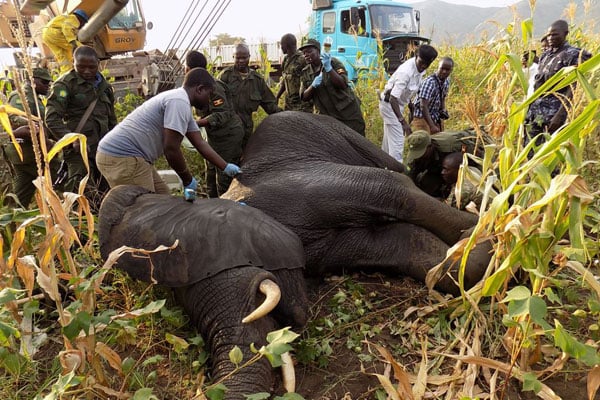Human-wildlife conflict: Uganda looks to Kenya

Uganda Wildlife Authority (UWA) staff rescue an elephant that had strayed into the farm of one of the people living near Queen Elizabeth National Park. Photo/Morris Mumbere
What you need to know:
The community conservancies moves to address human-wildlife conflicts in a manner not dissimilar to what is done in Laikipia County, northern Kenya.
With nearly 60 percent of its wildlife population outside protected areas, Uganda is embracing a new conservation approach tailored towards ending interactions with a negative outcome for wildlife and humans.
The community conservancies moves to address human-wildlife conflicts in a manner not dissimilar to what is done in Laikipia County, northern Kenya. In Uganda, much like Kenya, the climate crisis has triggered movements among animals and human populations that have put both parties on a collision path.
Ms Joyce Mbataru, the communications manager of the Kenya Community Conservancies Association, says community conservation is a fairly new model of conservation. First put to use nearly three decades ago, there are 238 conservancies per the Kenya Wildlife Conservancies Association.
The conservancies, which range from community, group and private, span nine million hectares. This translates to 16 percent of land mass spread across 29 counties in Kenya.
With nearly 60 percent of Kenya’s wildlife living in community and private lands, conservancies provide connected landscapes that complement national parks and reserves while enabling communities to benefit from wildlife management. From 90 percent of the global population of the Grévy’s zebra to 90 percent of the wolf hirola antelope population and 45 percent of the black rhino population, conservancies do their fair share of heavy lifting for animal populations.
Mr Sammy Leseita, the head of livelihoods at the Northern Rangeland Trust, says community conservation has lands between national parks and reserves registered to mirror the former; only they are owned and managed by communities.
“Through this, the communities can benefit from the wildlife, the trees, soils but as an organised entity” Mr Leseita says.
Land use
In Kenya, conservancies are a recognised land use under the Wildlife Act, 2013. This makes them an attractive land use option for communities and land owners. Mr Leseita, whose Northern Rangeland Trust has 43 community conservancies under its belt, says its model sets out to increase the bargaining power of communities with the national government and the county government.
“If you are a community member and you are sleeping hungry, why would you listen to anybody telling you to conserve land? It wouldn’t matter to you at all,” Mr Leseita says.
Peter Matunge, the chief executive officer of the Laikipia Conservancy Association, shares similar sentiments.
“Conservancies are providing security for wildlife and giving communities an opportunity to participate and also benefit from the wildlife,” Mr Matunge, whose association has a membership of 28 conservancies, states, adding, “In this landscape of Laikipia, conservancies are contributing Ksh6.1 billion to the economy and employs about 4,700 people.”
Mr Matunge argues that centralising conservation was a big mistake that led to increased poaching and ultimately reduction in wildlife numbers in Kenya.
Ugandans working to develop the country’s Wildlife Conservancy Movement have been advised by Mr Leseita to get the goodwill of the central government. Mr Matunge adds that wildlife ownership management should be given to communities so that they own and manage it for the interest of future generations. The need to strengthen community participation in wildlife conservation also goes without saying.
Previously, Uganda’s wildlife management approach lacked sufficient community participation. The watershed moment came in 2013, with players moving to replicate models in Namibia and Kenya.
Although early attempts to pilot conservancies faced challenges due to limited capacity and technical guidance, a few feats—such as the establishment of an umbrella body—have been registered. Established in March 2021, the umbrella body counts 18 member conservancies under its care.
“We believe community conservation is about uniting communities, improving livelihoods, conserving wildlife, promoting coexistence, and strengthening local institutions while preserving traditional cultural practices,” Mr Walter Odokorwot, the chief executive of the body, says, adding that 12 of the 18 member conservancies are managed directly by communities.




